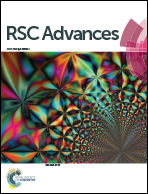Cu–EDTA-modified APTMS-Fe3O4@SiO2 core–shell nanocatalyst: a novel magnetic recoverable catalyst for the Biginelli reaction†
Abstract
A novel copper–ethylenediamine tetracarboxylate modified core–shell magnetic catalyst is introduced. The prepared catalyst was fully characterized by various spectroscopic analyses such as XRD, SEM, FT-IR, EDX, ICP, and CHNOS. After characterization, its activity was evaluated as a supported transition metal catalyst in the multi-component Biginelli reaction. The novel catalyst acts as an efficient heterogenized catalyst for synthesis of 3,4-dihydropyrimidin-2(1H)-one/thione derivatives in solvent-free conditions. A wide range of biologically active dihydropyrimidin-2(1H)-one/thiones were synthesized in the presence of the novel catalyst in 10–15 minutes with high yields (85–98% isolated yields). In addition, the reusability of the catalyst was tested by an external magnet. The investigation showed that no notable reduction of yields was observed after reusing over ten runs, proving its stability during recycling processes. More importantly, very small amounts (0.35 mol%) of the novel catalyst were required to result in the maximum turnover frequency of the Biginelli reaction obtained to date (TOF about 1000–1680 h−1 and total TOF over 14 000 h−1).


 Please wait while we load your content...
Please wait while we load your content...